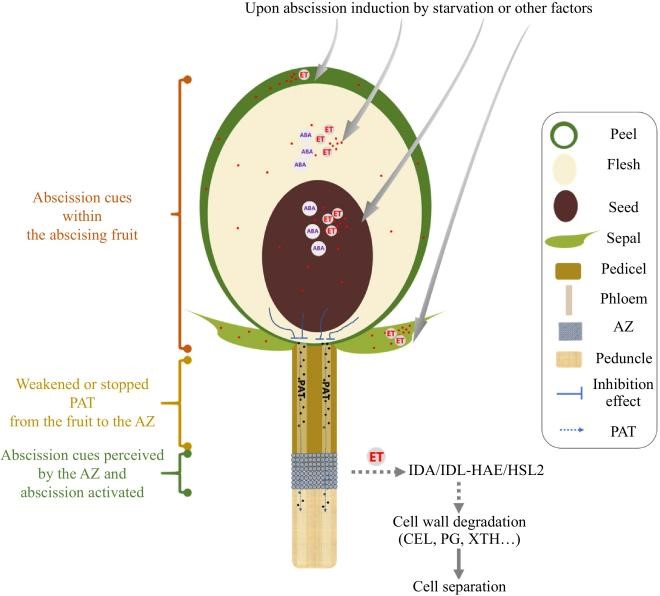Fruit abscission is pivotal for the vegetative and reproductive growth of fruit crop species and has been a focus of plant biology research from historical to modern times. This natural process, crucial for thinning excess flowers and managing fruit loads, involves complex genetic and hormonal interactions, particularly in model plants like Arabidopsis and tomato. However, challenges persist in woody fruit crops such as litchi and citrus, where uncontrolled abscission leads to significant fruit drop, necessitating physical and chemical interventions to maintain yield.
A review article (DOI: 10.48130/frures-0024-0007) published in Fruit Research on 02 April 2024, aims to explore the specific mechanisms of fruit abscission in woody species, focusing on signal generation, transmission, and perception within the abscission zone, areas that remain underexplored and crucial for improving commercial cultivation practices.
This review comprehensively examines the mechanisms of fruit abscission in woody fruit crops, emphasizing the critical roles of abscission zones (AZs) and the molecular pathways that regulate this process. The AZs, forming early during organ development, are specialized tissues that differentiate to facilitate cell separation upon receiving abscission cues. Significant advances in genetic and molecular studies, particularly in model plants like Arabidopsis and tomato, have highlighted the role of key transcription factors and signaling pathways, such as the IDA-HAE/HSL2 module, in regulating abscission. However, research on woody fruit crops lags, with many regulatory genes and mechanisms still unidentified or poorly understood. Furthermore, the review points out that ethylene and auxin play central roles in the abscission process, with ethylene promoting and auxin inhibiting abscission. This review focuses on the signals leading to abscission, such as the depletion of polar auxin transport (PAT) triggered by carbohydrate shortages, which then activates activated ethylene signaling pathways. This cascade is hypothesized to be sensed by the IDA-HAE/HSL2 pathway, leading to the initiation of the abscission process.
According to the study’s lead researcher, Jianguo Li, “In this review, we focus on fruit abscission, particularly discussing the nature of abscission cues within the abscising fruit, how these signals are generated and transmitted, and how the abscission zone cells perceive and respond to these signals in woody fruit crops.”
This review identifies significant gaps in understanding the specific tissue roles in hormone synthesis and the interactions between ethylene and auxin in regulating fruit abscission, suggesting critical areas for future research in the physiology and molecular biology of fruit abscission in woody crops.
References
DOI
Original Source URL
https://www.maxapress.com/article/doi/10.48130/frures-0024-0007
Authors
Minglei Zhao1,2,3,4 , Chun-Lin Shi5 and Jianguo Li1,2,3,4*
Affiliations
1 State Key Laboratory for Conservation and Utilization of Subtropical Agro-Bioresources, South China Agricultural University, Guangzhou 510642, China
2 Guangdong Laboratory for Lingnan Modern Agriculture, Guangzhou 510642, China
3 Key Laboratory of Biology and Genetic Improvement of Horticultural Crops (South China), Ministry of Agriculture and Rural Affairs, College of Horticulture, South China Agricultural University, Guangzhou 510642, China
4 Guangdong Litchi Engineering Research Center, College of Horticulture, South China Agricultural University, Guangzhou 510642, China 5 ANGENOVO, Oslo 0753, Norway
5 ANGENOVO, Oslo 0753, Norway
About Fruit Research
Fruit Research (e-ISSN 2769-4615) is an open access, online-only journal to publish original research articles, new methods, perspectives, and reviews on novel discoveries in all areas of fruit science. The journal will focus on publishing basic and translational research with a broad impact in fruit science.



